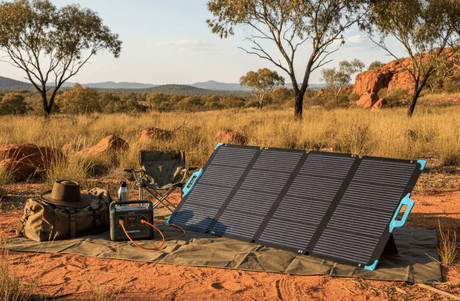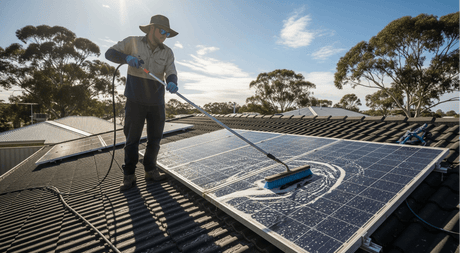What is a connector's role in a solar installation?
Solar connectors look relatively simple and you may not even notice them when shopping for solar components, but they are an incredibly important part of every system. After all, solar installations are essentially a grouping of connected devices.
Connectors do a lot of work. They require precise engineering to meet the safety and efficiency needs of a solar project. They have to be resilient to swings in weather and withstand varying voltage levels. But what exactly are they? How do connectors work? And how do they influence how you wire your system?
What are solar connectors?
In short, solar connectors attach different solar components together to produce a successful and safe flow of electricity within your system. MC4 connectors consist of a plug and socket design and are the most common connectors on new solar panels. So when you buy any new solar panel, it will be already fitted with two leads with MC4 connectors attached for you to get the power safely out of the solar panels and into the rest of your components.
It’s important to note that older panels were previously made with MC3 connectors. MC4 will not connect with older MC3 type connectors. The “MC” stands for “Multi Contact”, which is the brand name of a U.S. manufacturer. The “4” stands for the 4 mm diameter contact pin.
MC4 solar connectors consist of a male MC4 connector and a female MC4 connector. With MC4 solar connectors, you should only join solar cables that have a suitable diameter. If not, the connection will not be properly closed and will not function properly. The MC4 connectors work best with 4 mm or 6 mm solar cables. MC4’s allow you to connect panels by hand, but do they require a tool to disconnect, so they aren’t accidentally disconnected if the cables are pulled.
What should I know about solar cables?
Solar cables are the types of wires that are used to connect the solar panels together, as well as to other components in your system, such as charge controllers and inverters. It’s important to select the right cables, otherwise your system will not function properly, or worse, will be damaged.
What’s the difference between wiring in series and parallel?
Series wiring is when the voltage of your solar panels is increased by wiring the positive of one solar module to the negative of another solar module. When solar panels are wired in series, the voltage of the panels adds together, but the amperage remains the same.
On the other hand, parallel wiring is when the positives of multiple solar modules are connected together and all the negatives for the same modules are connected together. Wiring solar panels in parallel causes the amperage to increase, but the voltage to remain the same.

Why should I connect my system in parallel?
Parallel connections are often utilized in smaller, basic systems, and usually with PWM charge controllers. It is also often used in 12V systems with multiple panels because wiring 12V panels in parallel allows you to keep your charging capabilities 12V. The downside to parallel systems is that the high amperage makes it difficult for a system to handle without using very thick cables.
When wiring in parallel, you’ll want to use Y Branch Connectors. Sold as a pair, Y Connectors will maintain the voltage of the solar panel configuration to match the battery size. Renogy also sells 3 to 1 and 4 to 1 connectors, which you can select based on your system size.
Why should I connect my system in series?
Series connections are mostly utilized in systems with a MPPT Controller. Connecting your panels in series will increase the voltage level and keep the amperage the same. MPPT Controllers accept a higher voltage input, while still being able to charge your 12V batteries.
The benefit of series wiring is that it is easy to use when they have to travel long distances. The big downside to series systems is dealing with shading issues. When panels are wired in series, they all depend on one another. So if one panel is shaded, it will negatively affect the whole string of panels and the overall collection levels will be greatly decreased.
Why should I connect my system in series-parallel?
Charge controllers act as a big limiting factor to most solar panel systems because they are designed to only accept a certain amount of amperage and voltage. For larger systems where we want to stay within those parameters of amperage and voltage, we need to be creative and create a series-parallel connection. As the name suggests, you’re essentially using both series and parallel connections to achieve an optimal system. To create a series-parallel connection, you’ll make one string with 2 or more panels in series. Then, an equal string needs to be created and paralleled. 4 panels in series needs to be parallel with another 4 panels in series or there will be serious power loss.
What are extension cables?
MC4 extension cables, similar in concept to an electrical extension cord, are used to connect power from the connectors that connect the panels to a circuit breaker or charge controller. Just like an extension cord, which has a male plug on one end and a female plug on the other, an MC4 extension cable has a male connector on one end and a female connector on the opposite end.
How do you disconnect mc4 connectors?
As mentioned earlier, if you need to disconnect your MC4 cables, you will need a solar connector assembly tool. Simply insert the end of the tool into the side of the female MC4 connector. This disengages the locking mechanism of the male connector.
Conclusion
In order to collect, store, and transfer energy, a solar installation needs to utilize safe, strong, and efficient connections. Solar connectors make this possible by connecting solar panels with your charge controller, which connects the other crucial elements of your system, such as inverters and batteries. By understanding how solar connectors function and how wiring your system can greatly impact your system’s performance, you’ll be best equipped to build a powerful and safe system that will meet all of your energy needs.





![What Is a DC to DC Battery Charger [Comprehensive Guide]](http://au.renogy.com/cdn/shop/articles/IMG_3829_bd86de74-31d6-49fd-b9d5-265bb723091d.jpg?v=1757582605&width=460)



